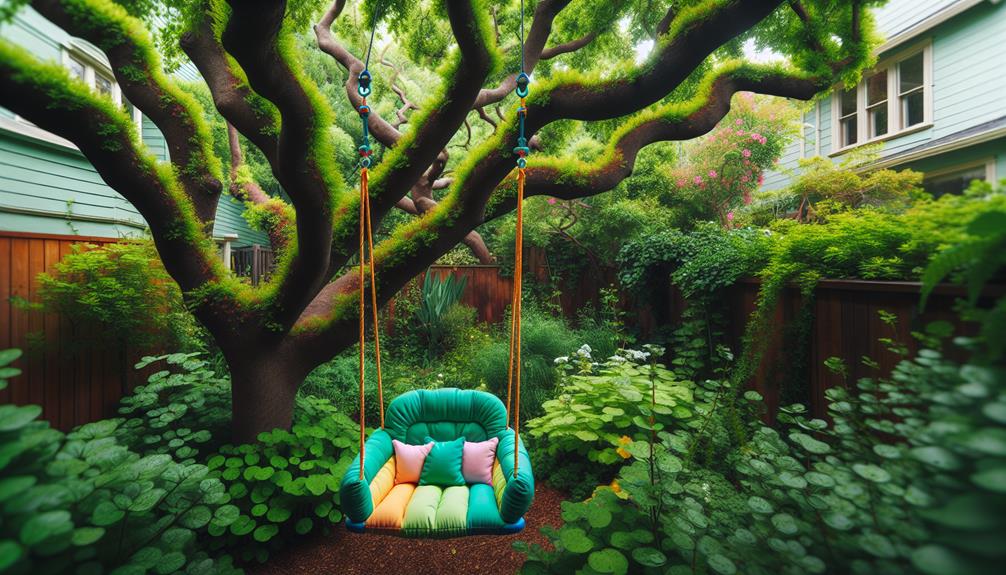When it comes to introducing infants to the joys of swinging, parents often wonder about the appropriate age for their little ones to start this activity. Safety and developmental factors play a crucial role in determining when a baby can comfortably use a baby swing.
Understanding the subtle signs that indicate readiness is essential in ensuring a positive experience for both the child and the caregiver. Stay tuned to discover the recommended age range and important tips for safely introducing your baby to the world of swinging.
Key Takeaways
- Baby swings are typically suitable for infants aged 6 to 9 months with improved head control.
- Ensure safety with proper fastening and supervision while using the swing.
- Introduce swinging gradually with gentle pushes and engaging interactions.
- Watch for signs of readiness like good head control, curiosity, and positive reactions to motion.
Safety Guidelines for Baby Swings
When considering the safety guidelines for baby swings, it is essential to prioritize the well-being and security of the infant above all else. Swing safety is paramount to prevent any potential accidents or injuries. Before placing your baby in a swing, ensure that the swing meets current safety standards, has a stable base, secure restraints, and no sharp edges that could harm the baby. Regularly inspect the swing for any signs of wear and tear that could compromise its safety.
Swing supervision is another crucial aspect to bear in mind. Never leave a baby unattended in a swing, even for a short period. Accidents can happen quickly, and supervision is key to ensuring the baby's safety while using the swing. Always follow the manufacturer's guidelines for weight limits and usage recommendations to prevent any mishaps.
Understanding Baby Developmental Stages
Understanding the developmental stages of a baby is integral to providing appropriate care and support as they grow and reach important milestones in their early years. It's crucial for parents and caregivers to be aware of the milestone markers and growth patterns that babies typically follow.
- Physical Development: Babies go through rapid physical changes in their first year, such as gaining head control, sitting up, crawling, and eventually walking.
- Cognitive Development: Cognitive abilities start to develop early on, with babies showing increased curiosity, memory retention, and problem-solving skills as they grow.
- Social and Emotional Development: Babies begin to form attachments, show preferences for familiar faces, and display a range of emotions as they interact with the world around them.
- Communication Skills: From cooing and babbling to saying their first words, babies progress in their ability to communicate with others, laying the foundation for language development.
Signs Your Baby Is Ready to Swing
To determine if your baby is ready to use a swing, observe their physical and developmental cues that indicate readiness for this activity. Developmental milestones play a crucial role in determining when your baby is prepared for swinging. Look for signs such as good head control, the ability to sit up with support, and the curiosity to explore their surroundings. These milestones indicate that your baby's muscles and coordination have developed sufficiently to enjoy swinging safely.
Physical cues are also essential indicators of readiness for a baby swing. Your baby should have steady neck control to prevent any strain while swinging. Additionally, check if your baby can hold their head upright without assistance.
Emotional cues are equally important; observe if your baby shows excitement or joy during movement activities. If your baby displays positive reactions to gentle rocking motions, they might be ready for the swinging sensation a baby swing provides. By considering these cues, you can determine if your baby is prepared for the enjoyable experience of using a swing.
Recommended Age Range for Baby Swings
The recommended age range for baby swings typically aligns with infants between 6 to 9 months old. During this stage, babies have usually reached important infant milestones that make swinging both enjoyable and beneficial for their development. When considering a baby swing, it's crucial to pay attention to swing weight limits to ensure your baby's safety and comfort.
Key Points to Consider:
- Infant Milestones: Babies within the 6 to 9-month age range often exhibit improved head control and coordination, enhancing their swinging experience.
- Swing Weight Limits: Adhering to the specified weight limits on baby swings is essential for preventing accidents and ensuring the longevity of the equipment.
- Safety: Always prioritize safety by fastening seat belts and harnesses properly to keep your baby secure while swinging.
- Supervision: Never leave your baby unattended in a swing to minimize any potential risks or hazards.
Taking these factors into account will help you create a safe and enjoyable swinging experience for your little one.
Tips for Introducing Baby to Swinging
When introducing your baby to swinging for the first time, it is important to approach the experience with patience and attentiveness to ensure a smooth and enjoyable transition. Outdoor adventures can provide excellent opportunities for sensory stimulation, aiding in your baby's development. Here are some tips to make the introduction to swinging a positive experience for both you and your little one:
| Tips for Introducing Baby to Swinging | Description |
|---|---|
| Choose a Safe Swing | Ensure the swing is age-appropriate and secure for your baby's safety. |
| Start Slowly | Begin with gentle pushes to help your baby get used to the motion. |
| Engage with Your Baby | Talk to your baby, make eye contact, and smile to create a sense of comfort and security. |
Frequently Asked Questions
Can a Baby Fall Asleep in a Swing?
A baby can fall asleep in a swing due to the soothing rocking motion that mimics the feeling of being held or rocked. This gentle movement can help in regulating sleep patterns and aiding in nap routines.
However, it is important to ensure that the swing is used safely and according to guidelines to prevent any potential risks. Always supervise a baby while they are sleeping in a swing to ensure their safety.
How Long Should a Baby Stay in a Swing at One Time?
When considering swing duration for babies, it is crucial to prioritize baby comfort and safety.
While swings can offer developmental benefits like soothing and promoting visual tracking, it is recommended that babies spend no more than 30 minutes at a time in a swing.
Extended periods may lead to discomfort or positional plagiocephaly.
To ensure a positive experience, frequent breaks and supervised use are advisable to prevent any potential risks associated with prolonged swing usage.
Are There Any Potential Health Risks Associated With Using a Baby Swing?
Just as a ship needs a steady hand at the helm to navigate the stormy seas, a baby swing requires vigilant supervision to ensure the safety and well-being of the precious cargo it carries.
Potential health risks associated with using a baby swing may include inadequate neck support leading to discomfort or injury, and sudden movements that could startle or harm the infant.
Proper supervision is essential to mitigate these safety concerns and ensure a secure swinging experience.
Is It Safe to Use a Baby Swing Outdoors?
When considering the safety of using a baby swing outdoors, it's important to take into account weather considerations and safety precautions. Ensure that the swing is securely anchored to prevent tipping over, and pay attention to any potential hazards in the surrounding area.
Extreme weather conditions such as strong winds or excessive heat can pose risks, so use the swing in a sheltered area when necessary. Always supervise your baby while using the swing outdoors.
Can a Baby Swing Help With Soothing a Fussy Baby?
Engaging in a bonding activity like using a baby swing can assist in soothing a fussy baby.
The gentle motion of the swing can provide comfort and relaxation, aiding in calming a fussy baby.
Additionally, the rhythmic movement can have developmental benefits by stimulating the baby's senses and promoting a sense of security.
When used under supervision and following safety guidelines, a baby swing can be a helpful tool in managing a fussy baby.
Conclusion
In conclusion, it is important to follow safety guidelines and consider your baby's developmental stage before introducing them to a baby swing.
Wait for signs that indicate your baby is ready, and aim to stay within the recommended age range for baby swings.
Remember to introduce your baby to swinging gradually and provide a supportive environment for them to enjoy this new experience like a gentle breeze guiding a bird into flight.

